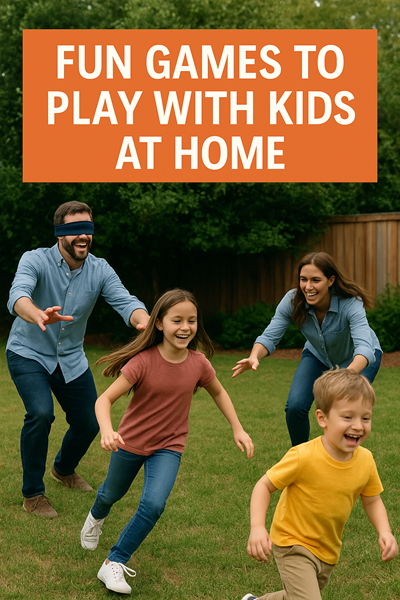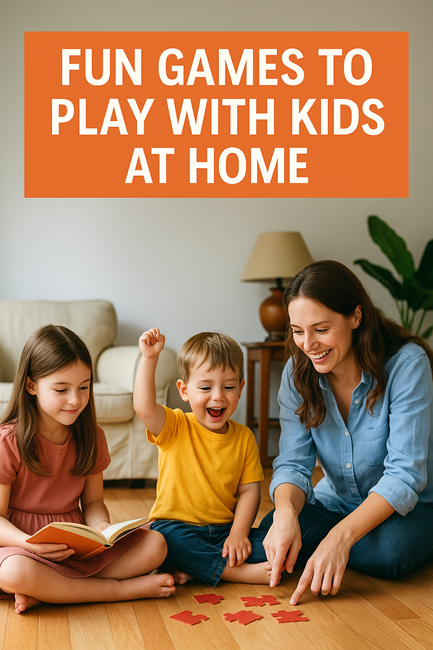Let’s be honest—keeping kids entertained at home while also making sure they’re learning something valuable can feel like juggling fire. With the digital age pulling their attention in every direction, parents often find themselves stuck between screen-time guilt and the pressure to be “super teachers.”
But what if learning didn’t feel like studying? What if it felt more like play?
That’s where Fun Educational Games to Play at Home come in. They strike that beautiful balance between fun and learning, allowing children to absorb skills in the most natural way—through play. Whether you’re a parent, guardian, or homeschooler, these games will help turn your living room into a lively little classroom where giggles meet “aha!” moments.
So grab some paper, blocks, or even just your imagination—here are Fun Educational Games to Play at Home that’ll keep your kids learning and loving it.

1. Word Treasure Hunt
Ideal for ages: 5–10
Skills learned: Vocabulary, reading, critical thinking
How to play:
Create flashcards with age-appropriate words your child is learning. Hide them around the house like mini treasures. Each time they find a word, they must read it out loud and use it in a sentence. For older kids, you can add bonus challenges like synonyms or spelling it backward.
Why it works:
It turns passive vocabulary learning into an adventure. Plus, movement helps memory—kids remember better when they associate learning with physical activity.
2. Math Bingo
Ideal for ages: 6–12
Skills learned: Addition, subtraction, multiplication, division
How to play:
Create bingo cards with math problems instead of numbers. For example, instead of “16,” the box could read “8+8”. Call out the answers (“16!”) and let them find the matching equation.
Why it works:
It turns repetitive drills into a game of luck and speed. You’ll be surprised how competitive kids can get when there’s a chance to yell “BINGO!”
3. Puzzle & Story Relay
Ideal for ages: 4–9
Skills learned: Storytelling, sequencing, motor skills
How to play:
Have a simple puzzle (9–16 pieces is good). After every piece they correctly place, ask them to add a sentence to a story you’re building together. By the time the puzzle is complete, so is your story!
Why it works:
This game builds narrative thinking and keeps hands and brains busy. It’s also a perfect bonding activity that sparks creativity.
4. Memory Tray
Ideal for ages: 3–8
Skills learned: Observation, memory, vocabulary
How to play:
Place 10 small objects on a tray—pen, spoon, toy car, crayon, etc. Give your child 30 seconds to memorize them. Cover the tray and ask them to name as many items as they remember.
Level it up: Ask them to describe the objects (“red crayon,” “metal spoon”) or group them (“3 toys, 2 kitchen items”).
Why it works:
It sharpens short-term memory and attention to detail—two crucial skills for early learners.
5. Guess the Emotion (Drama Game)
Ideal for ages: 4–10
Skills learned: Emotional intelligence, empathy, communication
How to play:
Write down different emotions (happy, sad, nervous, excited, etc.) on paper slips. Each player picks one and acts it out without words. The others guess.
Why it works:
It’s more than fun—it teaches children to recognize emotional cues and improves their understanding of others’ feelings. Great for building future social skills.
6. STEM in a Box
Ideal for ages: 7–13
Skills learned: Engineering, problem-solving, creativity
How to play:
Give your child a mystery box of household items—paper clips, straws, rubber bands, paper cups, tape, etc. Challenge them to build something: a bridge, a boat, or a tower that can hold a book.
Why it works:
It promotes engineering thinking—how to build, test, and improve. It’s hands-on learning that feels like solving a mystery.
7. Alphabet Scavenger Hunt
Ideal for ages: 3–7
Skills learned: Letter recognition, phonics, observation
How to play:
Pick a letter—say “B.” The child must find 5 things around the house that start with “B” (banana, book, ball…). You can play this with numbers, shapes, and colors too.
Why it works:
It blends language learning with real-world observation, making abstract concepts more relatable and concrete.
8. Home Store Roleplay
Ideal for ages: 4–10
Skills learned: Math, money handling, communication
How to play:
Set up a little store using toys, snacks, or stationery. Price them with fake currency. One person is the shopkeeper, the other the buyer. Take turns and practice giving the correct change.
Why it works:
Kids learn practical math skills in a pretend setting that builds real-life confidence and social interaction.
9. Art Meets Science
Ideal for ages: 6–12
Skills learned: Observation, nature study, art
How to play:
Pick natural objects—leaves, rocks, flowers. Have your child draw them in detail and label them. Take it further by researching the object: “What kind of tree is this from?” “What is this flower used for?”
Why it works:
It connects science and creativity, encouraging both observation and inquiry. A great way to combine art with academics.
10. Beat the Timer! (Speed Learning Game)
Ideal for ages: 5–11
Skills learned: Focus, time management, quick thinking
How to play:
Set a timer for 60 seconds. Give a task like “name 5 animals that live in water,” or “spell 3 words that start with S.” Make it progressively harder as they win rounds.
Why it works:
Kids love the rush of a ticking clock—it pushes them to think fast while having fun. Also teaches stress management in a healthy way.
Final Thoughts
In today’s world, learning doesn’t have to sit behind a desk. With just a little creativity, your home can become a space of exploration, discovery, and fun. These games don’t just teach—they bond, engage, and inspire.
And the best part? You don’t need fancy gadgets or hours of preparation. Just your time, your attention, and a willingness to let loose and play a little.
So the next time you hear “I’m bored,” you know what to do—turn your home into a playground of possibilities.
Frequently Asked Questions (FAQs)
1. Why are educational games important for kids?
Educational games help children learn through play, which is the most natural form of learning. They improve problem-solving, communication, memory, and motor skills—all while keeping kids engaged and entertained. Unlike traditional study methods, educational games reduce pressure and encourage curiosity and creativity.
2. How do I know if a game is age-appropriate for my child?
Always consider your child’s age, attention span, and current learning level. Start with simple games and gradually increase the complexity. For example, toddlers enjoy matching and memory games, while older kids might enjoy strategy-based or STEM-related challenges. Most of the games in this blog are adaptable for different age groups with minor tweaks.
3. Can these games be played by a single child or are they all group-based?
Many of these games can be played solo or with others. For example, “Memory Tray” or “STEM in a Box” can be enjoyed independently. Games like “Word Treasure Hunt” or “Home Store Roleplay” are better with parent participation or siblings. You can always modify the rules to suit the number of players available.
4. Do I need to buy special materials for these games?
No. One of the best things about these games is that they can be played using everyday household items—paper, pens, kitchen tools, toys, etc. The goal is to use what’s already available to encourage imagination and creativity, not to create an extra expense.
5. How much screen time should kids have if they are playing educational games on a device?
While some digital educational games are helpful, it’s essential to limit screen time based on age.
- For ages 2–5: No more than 1 hour per day of high-quality screen time.
- For ages 6 and above: Consistent limits that ensure screen time does not interfere with sleep, physical activity, and other behaviors.
Games listed in this blog are non-screen-based, promoting physical movement, interaction, and creativity.
6. How can I make sure my child is actually learning and not just playing?
Look for visible signs of learning, such as:
- Using new words
- Asking more questions
- Solving problems faster
- Applying skills in other settings (e.g., using math while shopping)
Also, talk to your child after play sessions. Ask what they enjoyed and what they learned. Reflection turns casual play into intentional learning.
7. How often should I engage my child in educational games at home?
You don’t have to turn your home into a 24/7 classroom. Aim for 20–40 minutes per day, 3–5 days a week. The key is consistency, not duration. The goal is to build a love for learning—not make it feel like a chore.
8. Are these games useful for children with learning disabilities or special needs?
Absolutely. Most games listed here are flexible and inclusive. For children with ADHD, dyslexia, or sensory issues, games can be adapted to match their pace and preference. In fact, hands-on learning often works better than textbook learning for kids with special needs.
If you’re unsure, consult your child’s therapist or special educator to tailor these games appropriately.
9. Can I use these games for homeschooling purposes?
Yes, these games are fantastic for homeschooling! They complement your academic curriculum by reinforcing concepts through interactive play. You can use them as revision tools, brain breaks, or even to introduce new concepts in a fun, pressure-free way.
10. What should I do if my child loses interest in a game quickly?
Children’s attention spans vary, and it’s completely normal for them to outgrow or lose interest in a game. When this happens:
- Switch up the rules
- Add time-based challenges
- Let your child create their own version of the game
- Rotate games every few days to keep things fresh
The more involved they feel in shaping the game, the more likely they are to stay engaged.
For more such Lifestyle Updates Follow Popnewsblend.

Hi, I’m Prashant Jain — a curious soul, storyteller, and content creator at heart.I’ve always been drawn to the world of entertainment, travel, sports, health & lifestyle — not just as a writer, but as someone who genuinely lives these experiences. Whether I’m binge-watching the latest OTT series, exploring offbeat spiritual destinations in India, or diving deep into wellness routines and cricket match insights, I love sharing what I discover with like-minded readers.
PopNewsBlend is my way of blending personal journeys with meaningful stories — ones that inform, inspire, and keep you ahead of the curve. Everything I write comes from real observations, hands-on experiences, and a deep passion for understanding the world around us.
Discover more from Popnewsblend
Subscribe to get the latest posts sent to your email.








Hi Prashant Ji,
Thanks for the updates given regarding children development.
now requesting you to confirm are given games available on google play or we have to make content 1st them we can play.
if these games available on play store pls confirm if possible provide some link
Hi Himanshu,
These games are not available on Google Play. Whole Idea is to keep kids away from the screen and enjoy quality time with them. For that content for these games can be created at home and played with kids.
Thanks,
Pingback: How Parents Anger Shapes Kids Behaviour - Know Before It's Late
Pingback: Old School Dads vs Modern Indian Dads: How Indian Fatherhood Has Evolved Over the Years
Pingback: Kids Obesity: Causes, Health Risks, and How Parents Can Take Action
Pingback: Letting Kids Fail: Why It’s the Best Parenting Strategy for Growth in 2025